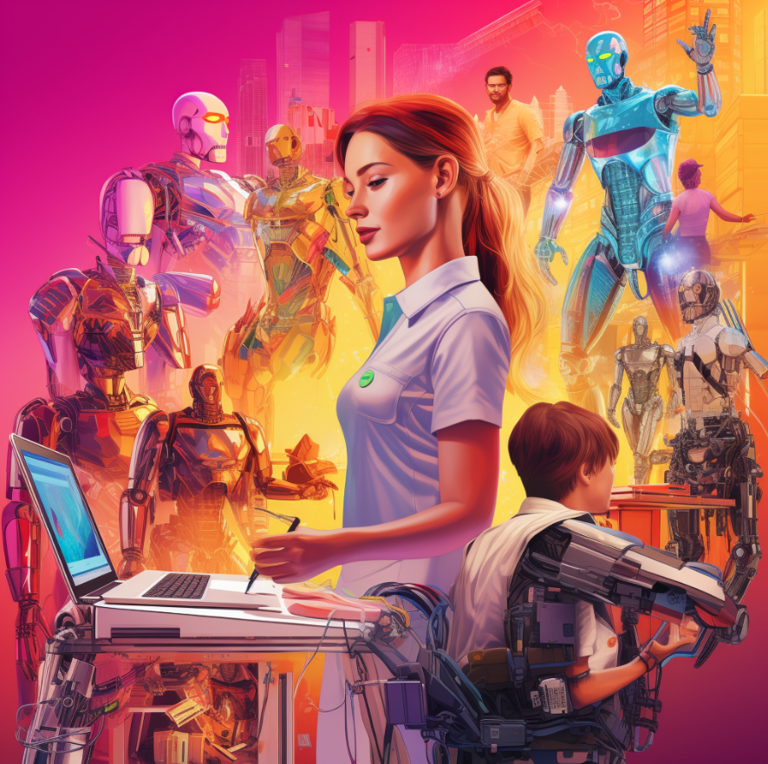
Back in the stone age people were performing activities such as hunting and gathering to survive.
Centuries have passed and many things have changed but one – sustaining our basic needs is still the foundation of our livelihood and there is no moving up the Maslow’s pyramid of needs unless the prime objectives are satisfied – regardless where or in which era we live in.
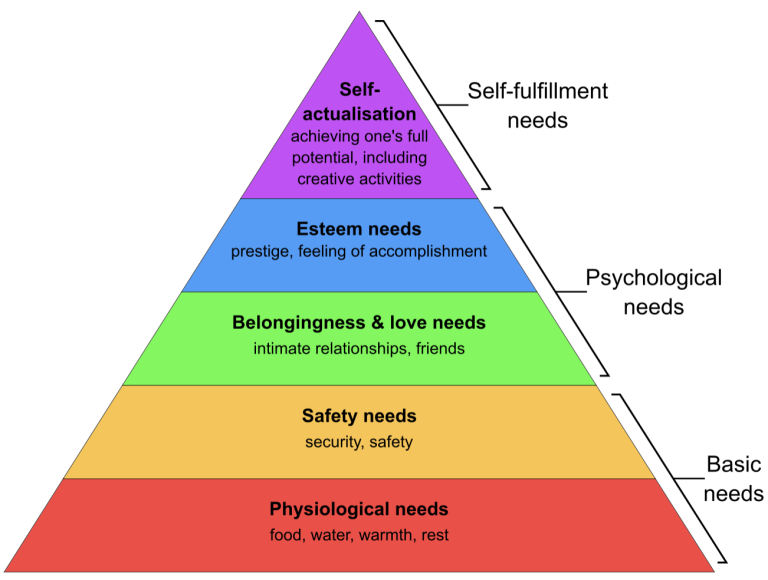
In this article we will analyse how work has evolved, technology advancements forced people to transition from manual to knowledge workers and our work attitude has changed by pandemics, forcing us to adapt to remote work.
This adaptation to remote work was considered impossible on this scale only a few years ago.
Our work activities in the pre-industrial era were based on collaboration within our communities. We used to barter, trade or sell our hand-crafted goods and farmed produce.
During the 1st Industrial Revolution in 1800, many of us moved from home-based workshops and fields to cities and the newly built factories. We worked long hours to maximise productivity of the steam powered machinery once operations were set in motion. The long working hours did, however, have a detrimental impact on human health and ultimately human productivity. This triggered a movement toward optimising working hours without compromising on outputs and satisfaction of plant owners.
This is how the 8-hour working day was born, although it is not commonly known that it originated in the 16th century in Spain for factory and fortification workers, and was followed by UK legislative bodies in 1884.
As such, the concept of the 8 hour working day has been engraved in our lives for much longer than we may appreciate or realise.
Back in time, it was relatively easy to quantify our productivity based on the number of products manufactured by a worker. Performance Management (known as Time & Motion Studies) required simple but the disciplined recording of both: time clocked by each worker and the number of goods produced by the end of each shift.

Despite the fact that the industrial revolutions introduced into our lives various changes driven by technology advancements (from automation through to interconnected cloud-based systems), turning our jobs from manual tasks into sophisticated activities, we still use Time and Motion Studies to control our working hours to assess people’s productivity.
On one hand we made extremely long strides in a very short time through technology progression as our work tools and the type of work we do have changed beyond recognition. On the other hand, we have not made any adjustments to the working systems or behaviours, even though our lives ceased to be dependent on daylight or seasons of the year.
Is this basic evidence that people are creatures of habit and afraid of changes?
Unlike the past, we now arrive home with tools in our pockets (e.g. laptops or mobile phones), that allow us to complete work outside our contracted working time, which we have already described as the well-defined, contracted 8-hr working day.
Also… the pandemic turned our world upside down, triggering our primeval survival mechanisms. Suddenly and without pre-warning people around the globe were forced to change behaviours to adapt to remote working conditions utilising the available technology.
This may not necessarily have been the biggest challenge. The mass isolation, remote communication, rapid change in routines and uncertainty about the future made many of us feel anxious and stressed. Yet with time, more and more of us started recognising the opportunities that remote work was introducing, such as: flexibility, liberation from long commutes, opportunities to tap into a fresh talent pool. If it wasn’t for the pandemic, it is highly probable that many of us would have not been able to experience the above in a long time.
As we emerge from restrictions caused by the pandemic, more employers are calling their workers back to the offices.
Some businesses e.g. PWC [1] advocate full flexibility allowing their employees to work virtually and live anywhere they want in perpetuity.
Some other companies such as BP, Siemens or Ford intend to adopt a hybrid working model, where time spent by employees in the office vs home working is divided [2].
Finally there are organisations, such as JPMorgan or Goldman Sachs, that are implementing strict, full time return to office policies [3].
Whilst the executives debate on the best future of work strategy – the “ how ” to do it, have they considered the key objectives – the “ why” they are doing what they are doing, for example:
Accurate definition of the “why ” is the crux to successful execution of the “ how” and implementation of the “what ” – the concept of Golden Circle advocated by S. Sinek could aid this decision-making process.
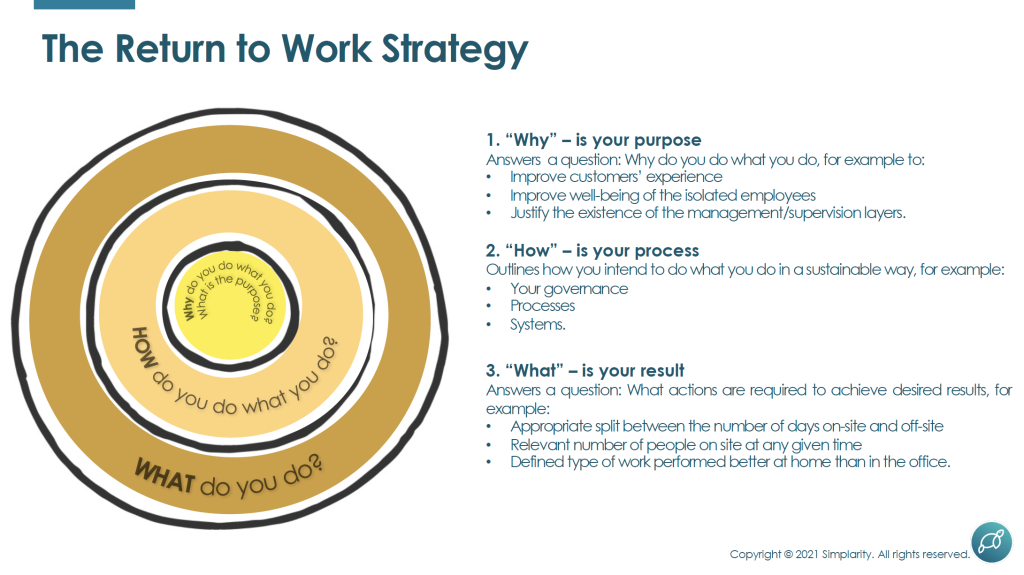
If any of the above are the leading decision-making factors, you may want to reconsider your “ why ” again, as according to McKinsey – productivity, customer satisfaction or employee’s engagement has actually increased in the remote workplace compared with pre-Covid 19.
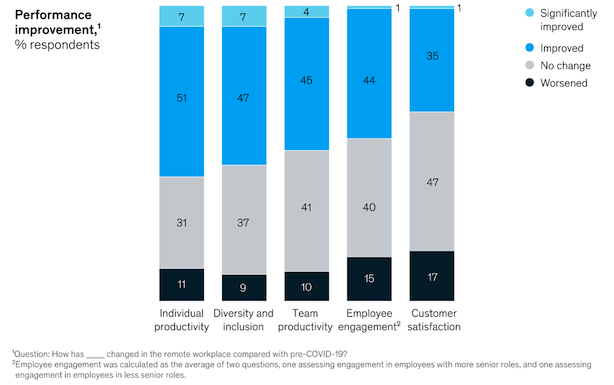
This however may not be sustainable, as these results have been measured over a relatively short period since the start of the pandemic in 2020.
Although the executives have 3 options as listed above to consider the return to work:
Many of them see the hybrid model as the happy medium, but is it really [4]?
If it is, can you answer these questions stipulating your “what ” selection:
This list of questions is not exclusive but requires considering before embarking on investing in transformation projects which may fail despite best intentions.
It’s not only about considering systems and practices to redesign the future of work. What we tend to forget about is the voice of our employee, as 80% of people, according to McKinsey’s interview, enjoy working from home [5].
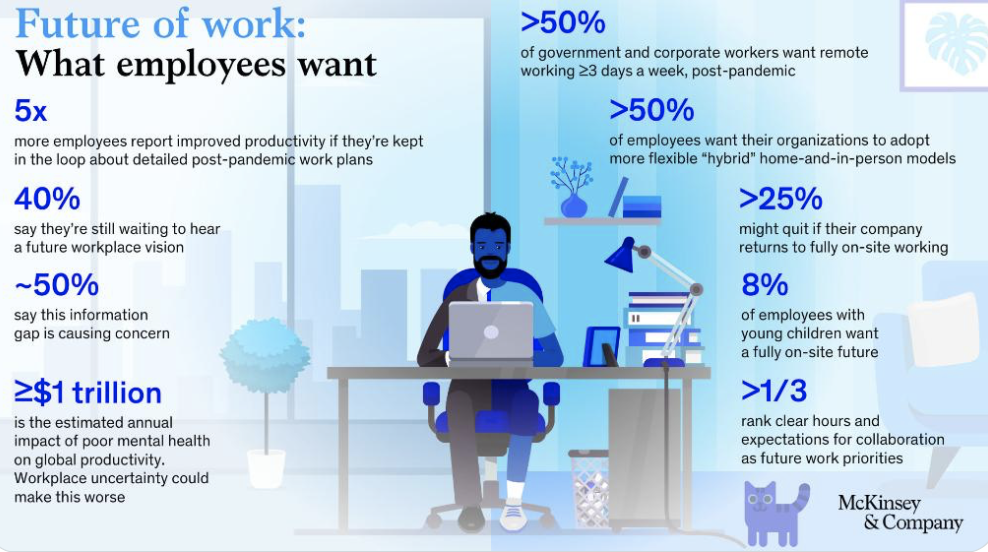
Not only do they enjoy working from home, furthermore, McKinsey’s research suggests that flexible working arrangements have already become a non-negotiable condition with employees hesitant to incur the personal costs of going to the office if they think they will have exactly the same interactions that could have been done virtually [6].
Indeed, another research by MIT Sloan ranks activities performed in the office in the order of effectiveness with energising interactions being the most effective.
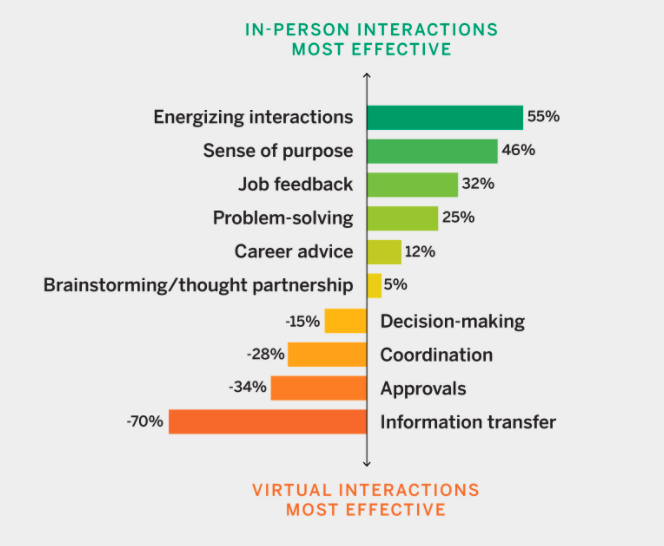
Again, it all depends on your line of business – traditional office layout (hot desks or cubicles) are more suitable for head-down work which is claimed to be more effective when working from home, whereas where tasks are automated and people are expected to perform more creative and innovative jobs, work space should enable positive collaboration and serendipitous interactions to spark new ideas and creative thinking.
The bottom line is that by not recognising employees’ expectations, some organisations may be running into a disconnect between management and employees, which may well surface in reduced engagement or attrition.
There is no one silver bullet to address challenges related to the future of work. One thing is certain – whilst technology enabled us the adaptation for remote working, the pandemic made the impossible possible – it changed our mindset with regard to work routines and practices.
Therefore, in order to avoid unpleasant surprises such as disconnect between you and your team, loss of trust or worse – your top talent, why not let your employees’ voice be heard? Why not understand their needs and expectations before defining return to work “fit-it-all” system?
Why should you engage your employees in the decision-making process? An answer to this question is relatively easy – to avoid losing your talent in the times of its scarcity [7].
This is the simple supply and demand dynamics, where sought-after individuals will be the decision-makers of employment Terms and Conditions that fit their specific circumstances.
This paradigm shift is on a global scale and will impact some businesses regardless of where in the world they are based, as Cloud solutions have no limits or borders.

What could this mean to you and your business? Losing your experienced team members and, with that, an inevitable investment in the recruitment process, time required for training to bring in new employees at the required level of expertise, etc.
As executives start to realise the inevitable shift from utilisation of assets to people-centred practices, more emphasis is put on equipping managers with the desired social, emotional and cognitive competencies and prioritising re-skilling of their leadership teams [8], to win this struggle for talent since “People leave bad managers, not companies” (after Marcus Buckingham).
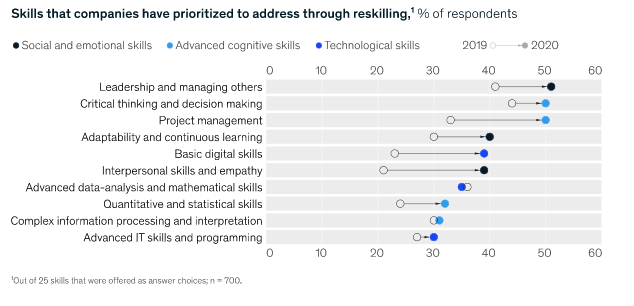
Human ingenuity and innovation are critical success factors for businesses to stay competitive in the digital era.
To achieve this, management will need to be kept accountable for enabling creative and supportive work environment, clarity of goals and outcomes, effectiveness of performance based on tangible outputs (e.g. improvements, solutions, results) not inputs (e.g. clocked 8hrs working days or the number of mouse clicks per day), etc.
In conclusion, I will leave you with this quotation:
“We need leaders who are emotionally intelligent, and able to model and champion co-operative working. They’ll coach, rather than command; they’ll be driven by empathy, not ego. The digital revolution needs a different, more human kind of leadership.”
Prof. Klaus Schwab
For more insights on the Leadership of Tomorrow and key soft skills required to skilfully navigate the business in times of change and uncertainty, follow us on LinkedIn @SimparityUK.
Copyright© 2020-2024 Simplarity Limited